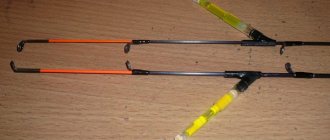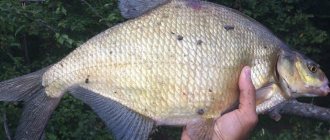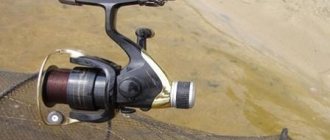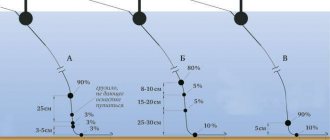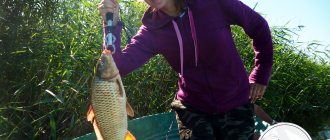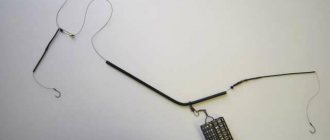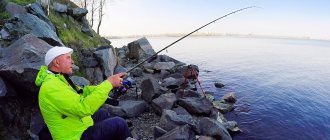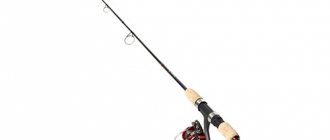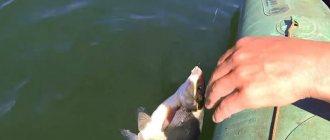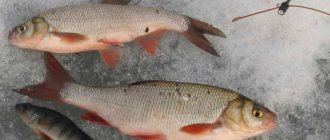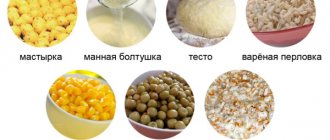Features of seasonal fishing on a feeder
Weather conditions affect the behavior of marine inhabitants. If you follow the exact procedure, then seasonal fishing with a feeder will be successful. In the spring, when the temperature in the reservoir drops to -10°C, the fish swims aground. In this case, live bait is best suited for fishing: worms or maggots. In the spring, bream begins to spawn , so from April onwards it is very difficult to catch this fish. At the end of May he becomes more mobile. You can find it in deep holes and gorges.
In the summer, from the first days of June, bream begins to look for food for itself . You can start fishing already in the middle of the month. On such warm, not hot days, the fish is quite mobile, so it will not hide. But in advance you need to study the bottom for places where she could hide.
An echo sounder will help you explore the underwater terrain, and marking fishing rods are also suitable. Autumn is a good time for feeder fishing . Bream, preparing for a long winter, begins to look for food for itself and quite often swims to the shore. During this period, he is not very active and spends more time at depth.
Important! When fishing for bream in early spring, you need to be especially careful. To withstand the jerks of the fish, the fishing line must be held between the index and middle fingers, smoothly pulling the prey to the surface so that it inhales air and calms down slightly.
Fishing is a delicate matter and requires special preparation. If you are counting on a big catch, then you need to find out about the upcoming weather, because this is a very important factor. At low temperatures and strong gusts of wind, fishing productivity is low. On hot days, the fish like to hide at the bottom, so don’t blame your luck on yourself, because the bream is simply not active.
The movement of bream throughout the day depending on the depth.
Those who like to sleep on rainy mornings will have to change their habits, since due to the enrichment of the reservoir with oxygen, the fish becomes most active and pliable at this time of day, and its metabolism also increases.
Read the description, characteristics and uses of sea bream.
Groundbait and flavors
Whatever feeder equipment is used for bream, we have nowhere to go without bait and flavorings.
You can either buy bait or prepare it yourself. The store has enough mixtures tailored purely for bream fishing. There are also universal baits available, and often with their help it was possible to achieve good results. Store-bought baits differ in price, there are cheap budget baits, medium and expensive “premium” baits, the difference here is of course in price and quality of ingredients. Of course, if the bream is inclined to bite, then it will be caught using any bait, and if it doesn’t bite, then the company will not help, here the difference will be in the number of bites and the size of the caught individuals. Manufacturers of good bream baits are VDE Traper, Sensas, Profi, DUNAEV, UNIKORM . It is worth considering that in different bodies of water the preferences of fish are different, and do not forget about the time of year. In cold water with bait, it is better to be careful and first fish without it, if the fish does not bite, then you can start feeding. Preferably, bait with animal food, diluted with soil directly on the pond. If you add flavorings, then only with spicy smells.
Lure
I would also like to note that if the bream is not pre-fed at this place, then at first it is better to use bait with inert particles, so that they, being carried away by the current, will attract the fish. Of course, in addition to the bream, there will be other guests, but then they can be cut off with bait with larger fractions or nozzles.
DIY bait for bream
To prepare the mixture at home, you can use the following bait ingredients . As a base (approximately 60% of the bait), take breadcrumbs, bran, macadamia, ground seeds. Feed components (30-35 percent) oatmeal, flax seeds, hemp seeds, corn or pea chaff, ground peanuts; to increase the fish's interest in bait, you should add maggots, bloodworms or chopped worms. 5-10% will be various additional components, rippers for standing water (coconut flakes, geysers) or binding components for flow (corn, wheat flour, oatmeal, baby food).
Don't forget about the various flavors. Bream are attracted by the smell of: seeds, peanuts, corn, garlic, anise, honey, gingerbread, peach and banana, tutti-frutti, strawberries.
Here are several options for homemade bait for bream
Recipe 1
- Breadcrumbs 1000 gr;
- Steamed millet 200 gr;
- Wheat bran 300 gr;
- Corn 100 gr.
- Ground cookies 300 gr;
- “Hercules” flakes 100 gr;
- Granulated sugar 50 gr;
Recipe 2
- Finely ground oatmeal cookies - 500 g;
- Rye breadcrumbs - 500 g;
- Oatmeal or biscuit flour - 500 g;
- Corn flour – 250 gr
- Corn grits - 500 g;
- Cocoa powder - 250 grams Ground roasted seeds - 500 grams
Recipe 3
- Boiled or steamed oat flakes 600 g;
- Breadcrumbs 600 gr;
- Ground roasted seeds or poppy seeds 600 g;
- Ground peanuts 200 gr;
- Bran 400 gr;
- Four drops of flavoring;
Recipe 4
- Bloodworm 400 gr;
- Boiled millet 2500 gr;
- Breadcrumbs 250 gr;
- Sago 250 gr;
- Ground seeds 500 g;
- Steamed hemp seeds 100 g;
- Powdered milk 150 gr;
- Anise 10 gr;
- Caramel 10 g;
Starting feeding - 10 feeders, then in case of no bite, re-cast the tackle with new bait every 5-10 minutes. If you have not over-wetted the bait, it should be washed out during this time.
Selecting a location
The choice of a specific area of the reservoir depends on seasonality, because at different temperatures the location of the fish changes. The habits of bream depend on the weather. During the cold season, it can bask in the shallows and wait out the heat at the bottom. Knowing how this or that fish behaves, you can catch it on the feeder at least every day.
But bream will bite especially actively at depth. The bottom should be strewn with shells - these are the places where the main food for fish is hidden, so there are most of them there. In the selected area, it is necessary to make primary bait. The “delicacy” spot should be small - this way the bream will not scatter to the sides, but will concentrate in a certain place.
Find out also what gear is most suitable for catching pink salmon.
Bream fishing spots
Where to catch it:
- On the rivers. The most promising places are the bends and turns of lowland rivers. The bottom, used by this fish as a shelter, must have descents to depth and form steps, as well as have shell growths. But bream does not live in areas with a sandy bottom.
- On the bays. In this case, as on rivers, most often bream will live on a muddy or clay bottom in conditions of reverse flow and the presence of a place for shelter. It descends to depth in the morning, in the evening it moves up along the edge to a depth of three or four meters, staying closer to the edge of the pits.
- In lakes and reservoirs. In these reservoirs, bream is searched for on deep-sea slopes. The bottom of the lake or reservoir should have algae and flat hills. At night, bream often moves to the shallows of the shore, rich in reeds or other aquatic vegetation, tightly adjacent to the slopes.
Let's celebrate! Regardless of the type of reservoir, the chosen fishing location will not be promising if it is characterized by a fast current.
How to make a feeder tackle for bream with your own hands
You can make a Gardner loop yourself using two methods:
- Paternoster , 2-3 cm in size, is tied to the end of the fishing line. A large loop is formed 10–20 cm higher (its length depends on the size of the coil). Next, you need to insert the main fishing line through the ring on the fishing rod, and attach the leash and hook to the smaller one. Secure the feeder on a large loop.
- At the end of the fishing line you need to tie a loop with a diameter of 15–20 cm, which should be cut into two uneven parts. A swivel is attached to these ends. On the shorter part, you should fix the feeder with a carabiner, and on the other, a leash and hook.
An asymmetrical loop is recommended for catching fish with less aggressive behavior. To make it, you should put a swivel on one end of the fishing line. Then tie a longer loop (about 0.5 m). Attach the feeder to the swivel and lift it up. This way it will not be fixed, but will move freely. On the same loop you need to make another one, at a distance of about 15–20 cm from the feeder. It is tied with a double knot, where a leash with a hook is attached.
A symmetrical loop is used more often by fishermen. It is tied to the main line without connecting elements. To do this, measure 50 cm of thread and fold it in half. At the ends you should tie a loop about 2-3 cm long. You need to put a swivel and a carabiner on one of the free ends. When using heavy feeders, it is recommended to tie a rubber bead under the swivel for shock absorption.
Did you know? Officially, the largest bream in the world was caught by the Finns in 1912 on the island. Vesijärvi. The weight of the fish was about 11 kg.
After this process, attach the end with the swivel to the main fishing line and tie a strong knot. Fasten the feeder to the carabiner. The size of such a loop will be approximately 20 cm. Usually this is enough, but sometimes they tie more in reserve. Just like the asymmetrical one, this loop twists when casting. Many people don’t like this, so it is made separately from the main line, choosing a stiffer thread.
For the “helicopter and two knots” , fluorocarbon fishing line is used, the diameter of which depends on the dimensions of the feeder. Monofilament is also used, but the first option is much stronger and is well camouflaged in water, because the fishing line is transparent.
Basic elements of feeder gear
Feeder tackle is assembled from several main parts. This is a rod, reel, fishing line, leash with a hook and a feeder.
Bream feeders
The main part of the feeder is considered to be the feeder. Any experienced fisherman will begin his gear setup with this important element. The feeder allows you to deliver bait to the right place in such quantity that the bream is interested in staying on the feeding spot. To catch bream, an angler needs to have several models of different sizes and weights.
To select the necessary set of bream feeders, you first need to decide on the place for your future fishing.
Feeder rod
Once the conditions for fishing bream have been clarified, you can move on to choosing a fishing rod. It is important to consider two points here.
Coil
To catch bream, you need a regular feeder reel with a gear ratio of 1:5, 1:6. The size of the spool depends on the thickness and length of the fishing line. So, to fit 150 m of fishing line with a diameter of 0.2 mm, you will need a reel of size 3000. When using thin fishing lines and leaders, you need to carefully adjust the friction brake. Then the jerks of a large bream will not become fatal to the equipment when hooking and retrieving.
fishing line
The main requirements for the main fishing line are strength and non-stretchability. This is important when fishing for large fish at long distances.
A braided line with a diameter of 0.12 mm best meets these requirements. A piece of monofilament fishing line 0.18 mm thick is suitable as a leash.
Hooks
Hooks for feeder fishing for bream are selected according to the bait used, as well as the size of the fish. Hooks No. 5-6 are used with baits such as pearl barley, wheat, and a foam ball. For larger baits (worms, corn, peas), you can tie hooks No. 7-10.
- This publication will tell you about various techniques and techniques for catching carp in August.
- A review of Kosadaka wobblers is waiting for you at this link.
- Read our article on how to prepare hominy for fishing.
When buying feeder bait, consider the body of water in which you are going to fish. If this is a river, then you also need to purchase special glue for the bait, which will make it more viscous. When purchasing, make sure that the packaging says “for the river” or “for river”.
Installation of feeder with feeder
Bream is considered a large fish, so the choice of equipment and its installation should be taken seriously.
Feeder tackle includes several elements:
- Rod . Its minimum length must reach 3.5 m, test weight - 90 g, class - “heavy”. However, these criteria vary according to the intended body of water. If the fishing spot is a wide river mouth, then the length should be up to 4.5 m, the test should be up to 120 g, the class should be “extra heavy”. On a narrow section of the river, a 3 m long rod is appropriate.
- Reel _ You should choose the simplest non-inertial type product with a spool up to 4000. Since fishing on a feeder almost always indicates a high degree of load on this part of the gear, it would be appropriate to choose a model with three or more bearings. The main condition is the correct setting of the clutch, so as not to injure the fish’s oral cavity during hooking.
- Hooks . These elements are selected high quality, ranging in size from 10 to 14 according to international numbering. They involve the use of large bait, and will not bend or break when catching a large specimen.
- Main line . Can be used both wicker and monofilament. It is better to take the first one because it is more durable. An important criterion when choosing is the lack of stretchability, which will allow you to more accurately cast the feeder over a long distance from the coastline.
- Leashes . The line should not be short. A thin and small product will be easily torn by a strong fish like bream. The length of the leashes is set during the fishing process. It can be 30–100 cm.
When fishing in fast currents, you need to take with you removable rod tips of varying degrees of rigidity. Too soft one bends and makes it impossible to see the bite, and hard one is not sensitive in weak currents or in standing waters.
Also find out how to assemble your own tackle for carp with a feeder.
There are the following methods for installing feeder equipment:
- The asymmetrical method involves using half a meter of hard fluorocarbonate fishing line. A main loop is made from it, about 15 cm long. A second one is also created under the main thread. The feeder is attached to a large loop and moves freely along the fishing line. A leash with a hook is also mounted here. The first one is longer than the feeder itself. In this way, the highest degree of sensitivity is created, and the fish will not detect the movements of the gear.
- When constructing a paternoster, you need to choose two fishing lines of different diameters.: for the base and additional. At the end of the first, a small loop is constructed. The leash is inserted into it and the hook is secured. Above this loop, a feeder is mounted on an additional fishing line. With this fastening option, during various hooks, only the feeder comes off, while the fish remains on the hook.
- The helicopter method is based on the selection of fishing line with a diameter of 0.2 to 0.3 mm, approximately a meter long. It is folded in half and a knot is tied at a length of about 15 cm. The next one is made at a distance of 1 cm from it. Thus, a large loop is needed to secure the feeder, and a leash and hook are fixed between the knots. Tackle made using this method increases the likelihood of the fish hooking itself at the moment of biting.
1 - the equipment is knitted on a fishing line with a diameter of 0.28 to 0.32 mm; 2 - the slip-on loop of the leash in the figure is loosened for clarity; in practice, it must be tightened.
For the current
The most common option for catching fish from the carp family using feeder gear is river fishing. For effective fishing, you need to choose an edge and a long, flat area among the terraces with steps and a shell.
When measuring the bottom, you should find the required area not only in the casting direction, but also in the opposite direction. It is in these places that, despite the current, larvae and bloodworms linger, which means bream come here in search of food.
When selecting a location, the main thing is to find such a promising point and immediately start baiting. It should be point-like, not scattered. This type of fish is attracted to small but abundant spots of food.
The main criterion in river fishing is the current. It depends on him what kind of bait, nozzle, equipment should be chosen. The casts should be clear, and the feeder should lie on the bottom in the same place, while the food should not crumble along the way. Since the edge can be steep and with a shell, the feeder must be adapted to the given fishing conditions. An abrasion-resistant shock leader can help with this, as can the correct choice of feeder.
Diagram of a cross-section of a reservoir valley indicating bream feeding points.
For standing water
Lake bream is an extremely neat and very timid fish. This means that the equipment needs to be lighter, and the feeder needs to be compact . Thin leashes and small hooks are also used in the feeder gear. It should be noted that in stagnant reservoirs bream is not so shy. In such reservoirs it is necessary to use longer casting.
The feeder for bream in still water is almost the same as for places with a rapid current, only the leashes are taken shorter - from 30 to 70 cm. If the bream behaves passively, then it is necessary to pull the feeders to the length of the leash after casting in order to move them away into the feeding area.
Important! When fishing for bream using baits of animal origin, the hook should be thin, which will allow the bait to remain on it longer.
Catching bream using feeder gear in still water is much more difficult than in the current, since it is much more difficult to attach a school of fish to the feeder. With this type of fishing, first you need to choose the right place and a suitable depression in the bottom of the reservoir in which the bait will take place. This is done using a marker float and a fishing rod.
Having selected the required recess and the desired type of bait, the next step is to mark a knot on the main line. This is done so that it is possible to clearly get to the baited place. When catching bream in still water, a paternoster and an asymmetrical loop are most often used with a feeder rig.
The feeder is taken in a round shape and weighs about 40 g.
Feeder installation for spring bream
In spring, bream is careful, stands at depth, casting is often long, so the feeder equipment must correspond to the fishing conditions.
You can read more about spring bream camps here - “Catching bream in the spring. Behavior.” The information is very useful, highly recommended for study.
Before moving on to the equipment, let’s discuss a number of equipment requirements for the feeder:
Now to the installation itself
Running rig for bream in spring
Explanations for installation
- The outlet for the feeder is always somewhat shorter than the twisted anti-twist. This eliminates entanglements.
- A regular swivel can serve as a replacement for the sliding bead.
- The outlet under the feeder guarantees free movement even on a soft bottom.
- A monoleader is the same shock leader, only made from monofilament fishing line. Fluor is also suitable, but it is somewhat more expensive. The length of 8 meters is optimal for beginners. But with enough experience, you can reduce it to 5 m, thereby slightly increasing the casting range.
- The length of the leash is tested on a pond. For neat, uncertain bites from 60 to 90 cm. For better detection (implementation), take a leash shorter than 40-60 cm.
Tips for fisherman: How to make a feeder for catching bream - How to best use
Shock leader diameter (mono)
| Shock leader | Feeder weight |
| 0.35 mm (17.5 lb) | 60 gr |
| 0.4 mm (20 lb) | 80 gr |
| 0.5 mm (27.5 lb) | 100 gr |
In European countries, fishing line is measured not in diameter, but in pounds, tensile strength (lb). 1 lb is about 474 g. or 0.4535 kg.
Main line diameter
| Main line | Shock leader |
| 0.25 mm | 0.35 mm (17.5 lb) |
| 0.3 mm | 0.4 mm (20 lb) |
| 0.4 mm | 0.5 mm (27.5 lb) |
Attach the shock leader to the main line
The Carrot knot not only holds well under heavy loads, but also passes freely through the feeder rings.
The shock leader in the figure is highlighted in dark color. The figure shows that the tips of the knot point forward. This means that they do not interfere with casting in any way.
Leash and hooks
Since bream in the spring is often neat, and the resistance when fishing is not strong, we equip the feeder delicately.
The diameter of the leash is from 0.14 to 0.18 .
Number hooks - 12, 13, 14.
By the way, it is the length of the leash that characterizes feeder fishing well. It is difficult to give exact recommendations on its size, since it varies from 10 to 150 cm. Feeder fishing in a strong current forces you to shorten the length of the leash. Also, a short leash of 5-10 cm has a flat feeder and a method that we wrote about in the article “Feeder fishing: budget tackle, trophy catch.”
Bait
The choice of bait for bream depends on the temperature of the pond, lake or river. In cold water, baits of animal origin are preferable: earthworms, maggots, bloodworms. In warm conditions, vegetable bait is suitable: pearl barley, corn, dough, bread, semolina.
Find out also how to catch chub using bottom and feeder gear.
Whatever the nozzle, sometimes it needs to be changed . Roll bread crumbs or cereals into balls with a diameter of about 0.5 cm and place them on a hook so that the end is not visible. If worms are used as bait, they are attached in bunches according to a similar principle. It is important to remember that they are alive and mobile.
Bloodworms can be combined with maggots, but if only the first one is taken, then it must be tied and planted in a whole bunch. It is recommended to take several types of bait for fishing, then by testing you can determine which one the fish like best.
Baits and baits
Choose bait for bream based on water temperature: in cold water, fish prefer animal baits:
- dung or earthworms;
- maggot;
- bloodworm;
And in warm water he will enjoy eating plant foods. Bites well on:
- hominy;
- barley;
- corn;
- bread dough;
- flavored wheat dough;
- small boilies;
Change any bait often to fresh one.
If you use semolina or bread as bait, then roll them into small balls with a diameter of 0.5-0.7 cm and place them on the hook so that its tip is not visible, but you can feel it.
The worms must move, and they must be pricked in bunches of 5 pieces so that the hook is not noticeable.
maggots with bloodworms. Bream likes this sandwich.
the bloodworms and plant them in bunches. This bait is universal and works well both in cold weather and in hot weather.
With the arrival of the first cold weather, the diet of bream changes radically. During this period, he prefers living animals, so it is better to switch to closed-type feeders (cylinders with small holes) designed to be filled with animal food. This type of feeder, such as springs, is rarely used in bream fishing. They can only be effective in closed reservoirs.
Bream does not stay in one section of the river; it constantly moves along its usual routes. Counting on the bait to end up on one of these trails would be a mistake. This approach is unlikely to be successful, so the selected point needs to be properly fed.
What to feed? Anglers attract bream with both store-bought and homemade mixtures. A good bait must meet three basic requirements. This:
- the presence of components of different sizes (fine particles carried away by the current attract fish from a long distance, and large elements settle and hold them at the point);
- optimal viscosity (the mixture does not fall out of the feeder at the moment of immersion, this process begins after a couple of minutes);
- seasonal aroma (sweet - for the warm season, the smell of animal components - for cold water).
Tips for a fisherman: How to make tackle for catching bream - What is the difference, pros and cons
You can prepare bait for bream with your own hands for a feeder that the bream will like no less than purchased bait. In the summer, the following composition works well:
- wheat grains (500 g);
- millet (300 g);
- bread crumbs (200 g);
- makha (100 g);
- corn flour (100 g);
- vanilla powder (50 g);
- food coloring.
Easy to cook. The wheat is fried and ground, the millet is boiled, and then mixed with all the other ingredients. Finely grated table beets can serve as a dye. Before use, it is necessary to add water to the mixture in doses and stir until it reaches the required consistency. After this, it should brew. The final touch is to add bait components (maggot or cut worm). This bait is called Salapin porridge for a bream feeder.
It is important to always remember that bream has an excellent sense of smell. If the bait is made from spoiled products or contains any foreign odors (for example, cigarette smoke), it will be of little use.
Bottom gear is ready for battle.
In this new part of the series I will reveal the secret of my rigs for catching bream in still water, their maximum sensitivity is guaranteed.
1. Classic sliding installations that prevent the formation of a loop. These are perhaps the oldest classic bottom rigs, which have proven themselves primarily when fishing for bream. They look very simple, which is why they are universally loved, although each of the assembled elements of these gears is a “child” of modern times, and this is proof that even the simplest things can get the most benefit. Let's consider!
Classic sliding rigs that prevent the formation of loops are the most effective for catching bream (in the picture: base - cord (0.20 mm) - Special Round Feeder 20 g - anti-twist tube 120 mm - large rubber stop - feeder fastener - monofilament leader, 25-30cm – hook).
This type of bottom gear is supported and accepted in feeder fishing competitions, where their effectiveness is undeniable. Necessary components for preparing bottom gear: 1. Anti-loop tube with reinforced end, 120 mm 2. Special feeder 20 g 3. Large silicone stopper 4. Feeder fastener 5. Leash 20 cm
The highlight of this equipment is the feeder - a classic feeder feeder, of the highest quality, every detail of which has been worked out to perfection. We took as a basis the classic round feeder feeder that is well-known and widely used by most fishermen, but we tried to correct all the shortcomings in it, “polishing” it to perfection. How did we achieve this and what did we change?
Classic form, in which every detail is carefully worked out.
Step-by-step installation of the equipment: First, you need to insert the main line into the tube, which prevents the formation of a loop.
It is important to know that the hook should always be on the side of the long part of the tube, because this is the only way it can prevent the formation of a loop!
After threading the rubber stopper.
. needs to be tied to the feeder clasp.
. the main line, using the method shown here.
The rubber stopper also serves as protection for the assembly, but primarily its task is to prevent the fastener from getting stuck in the tube.
The loop of the leash must be hooked onto the open end of the feeder fastener. Then tighten the closing elastic band. The quick clasp ensures a very quick change and fastening of the leash!
Made from a reliable carabiner tube that prevents the formation of a loop and the feeder will never break off or fly away.
In the picture, the “Helicopter” rig has a main cord made of braided fishing line (0.15 mm) – a large rubber stop – a quick fastener for attaching a leash, with a rubber anti-twist, a 30-40cm leash – a hook; large rubber limiter - a large loop to which the 25g feeder is attached
Necessary components for preparing bottom gear: 1. Base made of braided fishing line 0.15 mm 2. Large silicone stopper 3. Quick clasp for attaching a leash, with a rubber anti-twist “needle” 4. Feeder 25g 5. Leash 30 cm
The main feature of this equipment is a feeder, which has become famous under the name rocket or drop. A universal accessory that is indispensable for feeder fishing in both still and river water. Its advantage is that it has a larger capacity and therefore, when casting, we can place more bait on it than in closed models.
Feeder with a small mass (15, 25, 35 grams) for standing water, and with a larger mass (50, 70 grams) for river fishing. Characteristics: • Ideal shape, allowing longer and more accurate casts; • Exceptionally massive design that is simply impossible to squeeze with your hands; • Compared with conventional weaving, which is necessary to accommodate a larger volume; • Lead sinker, precisely adjusted by weight; • Special matte surface without shine;
Step-by-step collection of “Helicopter” equipment
Place a quick clasp between the two rubber stoppers to attach the leash.
Then, on a base of braided fishing line, you need to make a fairly large (about 20 cm) loop.
Tie it with a double knot.
After cutting off the excess end of the fishing line, the lower rubber stopper must be moved to this knot and the feeder must be tied to this loop.
Tips for fisherman: How to catch bream in winter with a jig - What to choose for fishing
Finally, all we have to do is place the leash correctly. To do this, the open end of the quick fastener used is closed with a rubber anti-twist. To thread the undergrowth into this needle, you need a tool with which carp anglers thread the fishing line through boilies, pellets and others. Using a boilie needle, thread the loop of the leader.
. then pull the anti-twist onto the leash, and hook its loop onto the hook of the quick fastener
This rubber cone is then installed correctly if you can completely push the carabiner (clasp) into it.
Bottom gear is ready for battle.
The fish may come!
The next part will look at my best bottom gear for river fishing in the same detail.
Author: Gábor Däme Photos: Gábor Nagy Drawings: Peter Tokács
Read how surgical loops for the feeder are made on our website here
This feeder equipment for bream fishing allows the angler to achieve significant results in catching trophies. After all, thanks to the feeder, the angler has the opportunity to fish at a considerable distance from the shore. At the same time, constantly feeding the fish and keeping it at the fishing point.
One of the popular feeder rigs for catching bream is the installation of a Gardner paternoster.
Namely, Gardner’s paternoster differs from others in that:
- Minimum number of tangles and overlaps. In skillful hands, with the proper experience, they are absent altogether;
- Great for beginners, but the same equipment is also used by feeder fishing masters, including athletes;
- Ease and speed of installation;
- Minimum number of additional elements on the equipment;
- The most sensitive equipment, the bite is immediately transmitted to the angler at the tip (tulip) of the feeder;
- The feeder slides along the length of the loop, which allows the fish to catch itself and many other advantages.
This installation is carried out on the main line. It is worth remembering that before tightening the knots and loops, they must be moistened, which will allow you to “not burn” the fishing line or cord.
The figure clearly shows that the only additional element is the swivel in the loop of the feeder, to which the feeder is directly attached via a carabiner.
Read how surgical loops for the feeder are made on our website here
Many beginners in feeder fishing use a simple rig with an anti-twist:
For a more visual representation of the step-by-step installation of feeder equipment for catching bream using the paternoster method from Gardner, watch the 3-minute video:
The diameter of the main line when catching bream on a feeder can be used 0.25 mm. When fishing with braided line - 0.18 mm.
A leash is suitable from 0.12 to 0.2, again depending on the intended trophies. So leashes with a diameter of 0.16-0.18 mm will not be very successful. The length of the leash varies from 15 to 150 cm. 20-40 cm can be considered optimal.
Select the feeder rod according to the fishing conditions. Removing fish from the shore, the strength of the current when fishing on the river. The optimal feeder rods have the following characteristics:
- Length 3-3.5 m;
- Test - 40-120;
- Construction is fast;
The feeder reel for bream fishing is suitable for 3500 according to the Shimano classification. A baitrunner on a reel would also be useful.
Another video instruction for installing equipment for a feeder when fishing for bream:
There are several types of feeder rigs when catching fish such as bream. For example, there is a rigging method called asymmetrical. This type of feeder gear can bring the fisherman excellent productive catches if everything is collected and installed correctly. It is a very sensitive type of feeder rig when fishing for bream.
Lure
Complementary foods consist of a base, binding components, dyes and flavors. Peas or corn are often used as the main ingredient.
Flavorings can be the following:
- fruit and berry;
- from ground dill;
- coriander.
If fishing takes place in cold weather, then add a worm and crushed bloodworms. Specialized stores sell ready-made feeder compounds. Bream prefers light-colored bait. The effectiveness of the catch can be significantly affected by feeding the fishing site.
Also read about preparing bait for catching carp.
It is necessary to take into account some features of this process:
- Bait starts a couple of hours before fishing.
- It is necessary to prepare several types of feed. One with small particles, the other with large ones.
- It is always recommended to use a composition with small particles first, because it disintegrates faster in water and sinks well into the depths, thereby luring fish.
- After several casts of mixtures of fine particles, it is worth switching to feeders with large particles. This can be done after a successful bite, since the bream will not be able to get enough of small food, and therefore will quickly leave the given place. Large complementary foods can hold him in longer.
- Both types of food can be alternated or mixed depending on the preferences of the fish.
- If the bite is weak, then you need to take a small mixture, if it is intense, only a large one.
There are several ways to throw bait into the chosen location:
- feeder for long-distance casting (from 50 meters from the shore and further);
- slingshot for medium throw (up to 50 meters);
- hand at close range.
Did you know? The largest bream in Russia was caught on the river. Vyatka in 1951. The weight of the fish was 5.8 kg, and 15 years later the record was repeated by a fisherman who caught a specimen with the same dimensions on Lake Ladoga.
Bait and bait for bream
As bait, baits with small and large fractions are usually used. Fine-grained fish is good because it quickly disintegrates and spreads throughout the water column, luring bream to bite.
This fish has an amazing sense of smell - up to 200 m. Approaching the bait at a distance of up to 100 m, its orientation is already based on hearing and vision. At this moment, the bream may become frightened by any noise, incl. from the careless movement of a fisherman.
Conditions for the formation of bait:
- it should not completely dissolve in water;
- consistency – heavy and viscous, with the exception of coconut flakes, sunflower seeds, etc.;
- experienced fishermen add a little river clay or soil to the feeder to create a neutral odor base;
- The bait is based on bait made from maggots, chopped worms, bloodworms, pearl barley, corn or other products of plant origin, previously scalded with boiling water;
- live bait significantly increases the interest of fish;
- In spring, for catching bream, vanilla, anise aromas and the smell of bloodworms or red worms are preferred;
- in summer and autumn they use baits with fruit, seed, pea and corn smells;
- For fishing in winter, baits with the scent of pineapple or the addition of red or black pepper have proven themselves to be excellent;
- The color of the bait should also be selected depending on the time of year - in spring and summer they prefer bright colors, in autumn and winter - brown and black;
- store-bought baits are great for beginners or those without time;
- When buying bait in a store, you should pay attention to the following: “Trapper”, “VDE”, “UNIKORM” and “Dunaev”, because it has a balanced composition of ingredients;
- the packaging of purchased bait must contain the inscription “for the river” or “for river”.
Fishing technique
When searching for the optimal place to catch fish from the carp family, it is necessary to take into account the behavioral characteristics of this species. Bream spends most of its life cycle at the bottom of any body of water; it also cannot tolerate stormy currents, although it most often lives in rivers.
Because of these features, parking should be chosen in relatively quiet and calm places, for example, in bays or on river bends. After sunset, bream moves closer to the coastline, and by dawn returns inland. It is preferable to choose a bottom that is clayey, silty or covered with shells; sandy is not suitable for bream.
The fishing process must begin with feeding and then follow certain recommendations:
- The food must be placed tightly in the feeder without attaching the leash to the equipment.
- Next, you need to inspect the opposite bank in order to outline a clear landmark for casting.
- The bait is thrown at full force if the fishing is carried out in an area far from the shore. As soon as the feeder comes into contact with the water surface, it is necessary to immediately close the line guide to prevent further unwinding of the line. The rod is installed on a special stand.
- When the feeder falls directly to the bottom of the reservoir, it is necessary to secure the line with a stopper. This is done to ensure that all subsequent casts are as close as possible to the original point.
- Subsequent fishing for bream using a feeder occurs according to the scheme of constant re-casting of the filled feeder, approximately once every five minutes.
We invite you to learn how to catch grass carp in the fall.
Why do we need feeders?
When catching large specimens, a large load is placed on the top of the spinning rod. With sudden jerks, it may become deformed or break. This is true when using braiding with a minimum stretch value. To compensate, standard bream fishing equipment includes a feeder.
How to catch crayfish at night with a flashlight: rules, equipment and recommendations
This is a shock absorber made of very dense rubber. It partially absorbs the load and reduces the number of jerks. Recommendations for use of feeders:
- attached at the base of the fishing line, in front of the leash;
- maximum insert length – up to 15 cm;
- loop-loop fasteners for quick dismantling and replacement;
- Used only for catching large fish.
A standard configuration feeder device usually does not have this component. But it is advisable to have it in the set. If a big fish bites, you can always quickly install a shock absorber.
Flat fishing tactics
Feeder fishing using flat rigs is notable for the fact that you can use several rods. We throw one of the feeders to the feeding point, and for the second one we can use search tactics. The essence of it is that you try to catch in different places. For example, you first cast to a shallow area located near the reeds.
If there are no bites within 5-10 minutes, change the point. Next time you can cast to a deeper area. For example, in the area of a coastal dump or behind the first edge. It is advisable to make short-range throws. This way it turns out more accurately and you don’t have to spend a lot of time unwinding the equipment.
To punch promising points, you can use the fan method, when each subsequent cast is made a little to the left or right of the previous one. When using this method, you should carefully ensure that the feeder is flying in the right direction. The casting distance should also be controlled by changing them.
Yes, this tactic differs from classic feeder fishing. But it brings good results. The undoubted advantage of method equipment is the fact that it can be used both on hard and soft ground and among underwater grass, one might even say in the thick of algae. If you hide the bait with a short leash, you will protect yourself from snags, which cause a lot of trouble.
What is the advantage of such active fishing with frequent changes of places? You can quickly locate the fish and start fishing.
When you get the first bite at one of the points, then make the next cast again to the same place. If there is a bite again and you manage to spot the fish, clip on and fish at this point. Casts are made at intervals of 10-15 minutes.
Naturally, the second fishing rod needs to be recast periodically. We set a good table at the point and the probability that the fish will come is quite high.
Another important point that is typical for fishing with method feeders. It concerns bites. When we see slight fluctuations in the tip, we should not immediately make a hook. Most often, at such moments, the fish tries the bait or eats bait from the feeder. Usually, hooks are made at the moment when the nod bends well or jerks sharply. At this moment, the same self-notching of the fish occurs. This is important to always remember.
It is clear that when fishing with a classic feeder rig, we react even to slight movements of the quivertip and strive to make a timely hook. This is all correct, but only for a feeder feeder with a long leash. Here is another significant difference between these fishing methods. When fishing flat, the bites are more colorful and obvious. Moreover, they often occur immediately, without preliminary tests. The top may be absolutely motionless, but after a second it “nods” furiously.
After such bites, a sweeping hook is simply not needed. The fish is already well on the hook and your task is to simply remove the rod from the rack and perform the landing. At the same time, make sure that the line is in a taut position at all times, otherwise the fish will either go into the reeds or simply fall off the hook. Remember that sharp hooks will lead to the fish’s lips breaking and you will not be able to pull it to the shore.
When flat fishing, some fishermen reel in the line immediately after casting so that the tip is slightly bent and the line is in a taut position. But when fishing flat, you shouldn’t do this right away. You should wait a little and then tighten the line. But it doesn’t have to be taut like a string. If you do this, there is a high probability that the feeder with the nozzle will submerge in the mud. In this case, you will have to wait a very long time for bites. The fish will not always rummage at the bottom in search of food. It’s better to cast to the clip and wait for a bite. When a good bite follows, you will see it anyway.
Symmetrical loop
It is very simple to make a symmetrical loop, but, nevertheless, its effectiveness is no less than that of a paternoster. It doesn't tangle as much and is more suitable for standing water.
It consists of the following elements:
- main line
- feeders
- two windbushes
- leader line and hook.
It is made as follows:
- Fold the fishing line in half and twist it in one direction.
- Make a knot 6-10 cm from the twist.
- Attach the windbreak to one fishing line.
- Make a knot at a distance of 20 cm from the branch.
- Twisting again
- Attach a windbreaker to the end and attach a leash up to 70 cm in length to it.
- Attach the hook to the leash to create a large loop.
- Attach the loop-to-loop feeder to the branch.
Other methods
Other fishing methods are not so often used in hunting specifically for bream, but are known to fishermen from fishing other carp fish: crucian carp, carp, carp. All the methods that we describe below are similar in construction, differing only in implementation.
Zakidushka
In our case, we will call a casting tackle, which differs from a simple donkey only in the presence of a rod and a spinning reel, which allow you to cast further and more accurately. Often the basis is spinning rods with a large dough and a slow action. A typical example is the Chinese “Crocodile” fishing rod. In its kind, it is considered practically indestructible, capable of breeding trophy fish of any power.
The reel is installed with a rear clutch, its size is 4000-6000 according to the Shimano-Daiwa classification. It is this “meat grinder” with a 5:1 gear ratio that is the most popular option. The bait is equipped with a sinker or feeder of appropriate weight for the specific flow. Most often, 2-3 leashes are used, one of which is tied below the load.
Pacifier
The work of the nipple is based on the fish’s love for sucking tasty components. For this type of gear, dough-like mixtures are used that adhere well to the base and do not disintegrate in water. There are several types of feeders used, where it is stuffed:
- cork
- spring
- banjo
- flat
Regardless of the design, the feeder is equipped with short leashes with hooks, on which the fish are caught.
Fishing time
In principle, bream can be caught on a feeder throughout the open water season, but with varying success.
Like any other fish, it has a time of peak activity. It occurs at the end of spring - mid-summer. In the hot summer, by the end of July the bite deteriorates somewhat, but still in August and September the angler can still count on good fishing.
As for the daily activity of bream in summer, it is higher in the morning and evening hours. During the daytime, schools of bream stay in their camp sites and practically do not react to the treats that fishermen offer them.
But at the evening dawn, the bream leaves its “day-time” places and goes out to feed on the shallows and rifts bordering the holes.
“Rigging a feeder for bream - The best time to catch it”
He feeds on them until dawn.
When the sun begins to rise above the horizon, schools of bream begin to return back to the depths, but the activity of the fish is still very high, and it can be successfully caught at the so-called transitions (places through which the bream wanders from its “table” to its “home” ).
Morning fishing for bream on a feeder is productive until approximately 9-10 a.m., so an angler who arrives at the reservoir at dawn has several hours to fish.
In August, as well as in early autumn, the hours of the morning bite shift somewhat. You can productively hunt bream until noon.
Helicopter in two knots
The two-knot helicopter rig, on the contrary, is used during active biting or in sections of the river with fast currents. The main advantage is the possibility of self-hooking fish.
For production, a rigid fishing line with a diameter of 0.25-0.35 mm is required, depending on the weight of the feeder. The best choice is fluorocarbon line.
Technology:
- We fold a fishing line about 20 cm long in half.
- We make a knot by measuring 15 cm when folded (figure eight).
- We move another 1 cm away from the knot and knit a new knot (figure eight).
- We attach the feeder using the “loop-to-loop” method.
- We attach the leash by placing it between two knots (but not the knot).
In still water
Fishing for bream with a feeder in still water has its own characteristics and difficulties. Here it is necessary to adhere to certain rules for choosing equipment.
The following points need to be taken into account:
- due to the lack of current, light feeders (30-50g) of any shape will be the most effective
- test for the feeder is selected smaller
- Feeder tips can be installed as soft as possible if there are no others
- casting in a standing reservoir is done far away, bream lives here further from the shore, which means the optimal length of the rod will be 3.5-4.0 m.
- the feeder is mounted using a paternoster, symmetrically with a loop, or a sliding one is used
- the thickness of the leash will depend on how the bream bites; if often, you need to use a thick and short one, rarely, a long leash with monofilament 0.12-0.14 mm
- Baiting in still water must be carried out very precisely, since there is no current and the fish will not hear the smell from a distance; a special slingshot can help out here
- to catch bream located at depth, you also need to remember to stock up on a landing net with a long handle
Onboard fishing rod
If the fishing area is deep, from three meters or more, the distance from the shore is large, beyond the control of any feeder, but the current is insignificant or absent altogether, use onboard fishing rods for fishing from a boat. This tackle is a short, up to two meters, fishing rod with a reel or reel for storing fishing line. As an option, use short, 3-4 meter fly rods.
The sideboards are equipped as follows:
- main line with a diameter of 0.20-0.22 millimeters;
- a sinker that allows you to stretch the cord in the water;
- two or three leashes with hooks of the required size for the bait used.
As a bite alarm, nods similar to those used in winter are used; they also help the bream to “play” with bait in the water column when the fish’s activity decreases.
Asymmetrical loop
Its difference from the symmetrical one is obtained only due to the arm of the loop. It is effective for fishing bream in still water with a consistently calm bite.
In order to make an asymmetrical loop, you need:
- Fold a fishing line up to 50 cm long in half.
- Tie its end to the main line using a knot, so that you end up with a wide circle on which you need to tie the next loop and attach the feeder
- The leash and hook are attached to the loop.
Feeder bait
The diet of bream and its “gastronomic” preferences vary from season to season. It is important to take this factor into account and create the right “menu”.
So, what kind of bait should you use and what to pay attention to:
- In spring and autumn, any components with a strong odor should be avoided, and fruity tones in bait should be avoided. You can add cinnamon, mint or anise. In combination 1kg/1tbsp. You can add dry blood.
- In summer, bream prefers sweet bait. Both natural spices, such as vanilla or coconut, and simple sugar are used. Live foods perform well immediately after a thunderstorm.
- In winter, the main place is given to the living component. Minimum fat and no strong aromas. It is advisable to achieve a fishy smell.
- A universal option for all seasons is boiled peas with breadcrumbs. To dilute the mixture, you can add cereals. It is especially important to mix semolina or other sticky grains into porridge to increase viscosity. Otherwise, all the porridge will leave the feeder in less than 10 minutes.
Here is just one possible recipe for universal bait:
- Boil water.
- Add 1 part millet, 1 part pea flour.
- Cook, stirring, for 4 minutes.
- Pour in 2 tablespoons of flavored sunflower oil.
- Turn off the gas and cover the pan with a thick cloth.
Proportion of water, peas and millet: 4:1:1.
Another rule is that the bait must contain the same product that will be used in the bait. Otherwise the effect will be less.
You should also not forget that bream recognizes colors well. Therefore, components with bright colors that are clearly visible in a monotonous aquatic environment, for example, corn or peas, can be mixed into the bait.
